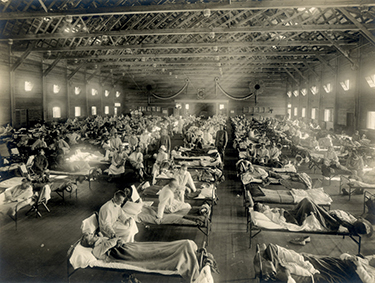Safe drinking water, seat belts, smoke-free buildings, modern sanitation and vaccinations are just some of the ways public health policies and advances have saved lives. A four-part PBS documentary that launches March 26 explores the rise and successes of U.S. public health, and also the the factors that threaten it.
“The Invisible Shield” traces U.S. public health history from the 17th century through the COVID-19 pandemic, showing how measures improved quality of life and increased life expectancy. The filmmakers point out that public health operates silently, preventing health calamities and countless deaths.
“Looking through the lens of public health is completely transformative,” series director Jason Kliot said at a screening of the series. “There was a moment when every single person who worked on this project realized public health is like fire, farming — it is what keeps us alive as a worldwide community. It may be the most important thing that exists that almost no one seems to know about.”
The four-hour series, created by RadicalMedia and supported by Bloomberg Philanthropies, shows how public health enables people to flourish by improving preventive health and making the workplace and everyday life safer.
The series also shows where public health needs attention. Cracks in U.S. public health response became apparent during the early years of the COVID-19 pandemic when politics influenced actions and public health protections divided Americans. Distrust and doubt over science hindered uptake of the COVID-19 vaccine. And the pandemic underscored America’s long history of structural racism, discrimination and health inequities.
Much of the documentary was filmed during the pandemic’s emergency phase and often shows the confusion of the time. In one scene, Abigail Echo-Hawk, MA, director of the Urban Indian Health Institute in Seattle, Washington, is bewildered when, instead of receiving personal protection equipment from the government for staff serving tribal American Indians, they received body bags.
Problems during the pandemic were compounded by a public health infrastructure that had been underfunded for decades, the series points out. Even before the pandemic, opioid use, suicides and alcohol misuse were increasing and lifespan was flat or declining depending on race or ethnicity. The pandemic escalated these markers of societal decline.
Amy Acton, MD, MPH, a former director of the Ohio Department of Health who is featured in the series, said the country needs healing and greater understanding about what happened during the pandemic’s emergency phase.
“Hopefully this documentary begins a dialogue we can have across the country,” Acton told The Nation’s Health.
Josh Sharfstein, MD, vice dean for public health practice and community engagement at Johns Hopkins Bloomberg School of Public Health, who is also in the series, said America is at a crossroads of health and has a choice which path to take.
“The emergency phase of the pandemic is behind us, and we are looking forward to what kind of country we want to live in and whether we will recognize and respect the importance of public health,” he told The Nation’s Health.
Other public health leaders appearing in the series include Georges Benjamin, MD, APHA executive director; Mary Bassett, MD, MPH, director of the FXB Center for Health and Human Rights at Harvard University; and Nicola Twilley, co-author of the book “Until Proven Safe: The History and Future of Quarantine.”
Watch a trailer:
Photo caption: A temporary emergency hospital is established at Camp Funston, Kansas, during the 1918–19 influenza pandemic. (Courtesy National Museum of Health and Medicine)